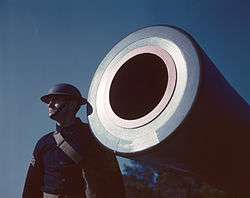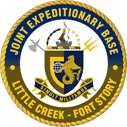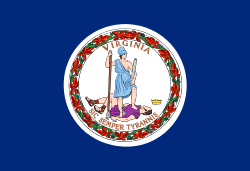Joint Expeditionary Base Fort Story
| Fort Story | |
|---|---|
| Part of Joint Expeditionary Base Little Creek-Fort Story | |
| Virginia Beach, Virginia | |
|
Command Logo | |
| Coordinates | 36°55′38″N 76°00′59″W / 36.9273°N 76.0164°WCoordinates: 36°55′38″N 76°00′59″W / 36.9273°N 76.0164°W |
| Type | Army Base |
| Site information | |
| Controlled by |
|
| Site history | |
| In use | 1914–present |
Joint Expeditionary Base-Fort Story, commonly called simply Fort Story is a sub-installation of Joint Expeditionary Base Little Creek–Fort Story, which is operated by the United States Navy. Located in the independent city of Virginia Beach, Virginia at Cape Henry at the entrance of the Chesapeake Bay,[1] it offers a unique combination of features including dunes, beaches, sand, surf, deep-water anchorage, variable tide conditions, maritime forest and open land. The base is the prime location and training environment for both Army amphibious operations and Joint Logistics-Over-the-Shore (LOTS) training events.
The base includes 1,451 acres (5.9 km²) of sandy trails, cypress swamps, maritime forest, grassy dunes and soft and hard sand beaches. The western beaches are wide, gently sloped and washed by the waters of the Chesapeake Bay. Eastern beaches are exposed to the rougher waters of the Atlantic surf. The
History
Installation history
Fort Story became a military installation in 1914 when the Virginia General Assembly gave the land to the U.S. Government "to erect fortifications and for other military purposes". The base was named for Gen. John Patten Story, a noted coast artilleryman of his day.

During World War I, Fort Story was integrated into the Coast Defenses of Chesapeake Bay, which included Fortress Monroe (Headquarters) and Fort Wool. After World War I, the base was designated a Harbor Defense Command and entered a period of post-war inactivity which lasted until the beginning of World War II.
In 1941, prior to the United States entering World War II, the Headquarters of the Harbor Defense Command was moved from Fortress Monroe to Fort Story, more land was acquired, and two additional harbor defense installations were added. In 1944, Fort Story began to transition from a heavily fortified coast artillery garrison to a convalescent hospital for returning veterans. By the time of its closing March 15, 1946, the hospital had accommodated more than 13,472 patients.

In 1946, after World War II, the first amphibious training at Fort Story began with the arrival of the 458th Amphibious Truck Company and Army DUKWS. Fort Story was officially transferred to the Transportation Training Command, Fort Eustis, and designated a Transportation Corps installation for use in training amphibious and terminal units in the conduct of Logistics-Over-The-Shore operations.
Fort Story was declared a permanent installation on December 5, 1961.
Historic features

Joint Expeditionary Base Fort Story has three historic sites. The Cape Henry Memorial Cross marks the location where the Jamestown Settlers first landed in 1607. The Old Cape Henry Light was the first lighthouse authorized and built by the Federal Government. At the Battle of the Virginia Capes Monument, there is a statue of French Admiral François Joseph Paul, comte de Grasse to commemorate the famous sea battle on September 5, 1781 which prevented the British from reaching Yorktown during the American Revolutionary War.
Also of historical interest, the new Cape Henry Lighthouse was completed in 1881 and is still maintained by the US Coast Guard as an active coastal beacon. The passenger station built in 1902 and served by the original Norfolk Southern Railway was restored late in the 20th century and is used as an educational facility by the Army.
Coastal artillery batteries consisting of four 16-inch M1920 howitzers were emplaced at Fort Story in 1922, and four 16 inch ex-Navy Mark II guns were installed during World War II. These guns, along with matching batteries located at Fort John Custis on Cape Charles and batteries at Fort Monroe on Old Point Comfort, were used to guard the entrance to Chesapeake Bay against an attack by hostile naval forces. These weapons were removed in 1948 and the large casemated gun emplacements and former ammunition bunkers are currently used for storage.
An Army Nike Missile battery was located on Fort Story from 1958 to 1974.
Current utilization
Command structure
As a result of a 2005 Base Realignment and Closure recommendation, Fort Story operations were transferred to the United States Navy. On October 1, 2009, Fort Story and Naval Amphibious Base Little Creek merged, and Fort Story officially became Joint Expeditionary Base Fort Story.[2][3]
Tenants
The following organizations were present at Joint Expeditionary Base Fort Story in 2009:
- AAFES
- 11th Transportation Battalion
- Army Reserve Center
- U.S. Army School of Music
- Directorate of Training and Doctrine
- FORSCOM Logistics Training Cluster, Saltwater Annex
- U.S. Marine Corps Security Cooperation Group
- Naval Special Warfare Group 2 Ranges
- Navy Explosive Ordnance Disposal Training and Evaluation Unit Two
- Navy Explosive Ordnance Disposal Mobile Unit 10
- Naval Undersea Warfare Center
- Shipboard Electronic Systems Evaluation Facility
- NATO Communication Logistical Activity

